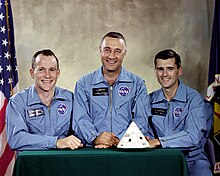Apollo 1

Grissom, White, and Chaffee in front of the launch pad containing their AS-204 space vehicle
|
|
| Names | AS-204 |
|---|---|
| Mission type | Crewed spacecraft verification test |
| Operator | NASA |
| Mission duration | Up to 14 days (planned) |
| Spacecraft properties | |
| Spacecraft | CSM-012 |
| Spacecraft type | Apollo Command/Service Module, Block I |
| Manufacturer | North American Aviation |
| Launch mass | 20,000 kilograms (45,000 lb) |
| Crew | |
| Crew size | 3 |
| Members | |
| Start of mission | |
| Launch date | February 21, 1967 (planned) |
| Rocket | Saturn IB AS-204 |
| Launch site | Cape Kennedy LC-34 |
| End of mission | |
| Destroyed | January 27, 1967 23:31:19 UTC |
| Orbital parameters | |
| Reference system | Geocentric |
| Regime | Low Earth orbit |
| Perigee | 220 kilometers (120 nmi) (planned) |
| Apogee | 300 kilometers (160 nmi) (planned) |
| Inclination | 31 degrees (planned) |
| Period | 89.7 minutes (planned) |
 Left to right: White, Grissom, Chaffee |
|
Apollo 1, initially designated AS-204, was the first manned mission of the United States Apollo program, which had as its ultimate goal a manned lunar landing. The low Earth orbital test of the Apollo Command/Service Module never made its target launch date of February 21, 1967. A cabin fire during a launch rehearsal test on January 27 at Cape Kennedy Air Force Station Launch Complex 34 killed all three crew members—Command Pilot Virgil I. "Gus" Grissom, Senior Pilot Edward H. White II, and Pilot Roger B. Chaffee—and destroyed the Command Module (CM). The name Apollo 1, chosen by the crew, was officially retired by NASA in commemoration of them on April 24, 1967.
Immediately after the fire, NASA convened the Apollo 204 Accident Review Board to determine the cause of the fire, and both houses of the United States Congress conducted their own committee inquiries to oversee NASA's investigation. The ignition source of the fire was determined to be electrical, and the fire spread rapidly due to combustible nylon material, and the high pressure, pure oxygen cabin atmosphere. The astronauts' rescue was prevented by the plug door hatch, which could not be opened against the higher internal pressure of the cabin. A failure to identify the test as hazardous (because the rocket was unfueled) led to the rescue being hampered by poor emergency preparedness.
During the Congressional investigation, then-Senator Walter Mondale publicly revealed a NASA internal document citing problems with prime Apollo contractor North American Aviation, which became known as the "Phillips Report". This disclosure embarrassed NASA Administrator James E. Webb, who was unaware of the document's existence, and attracted controversy to the Apollo program. Despite congressional displeasure at NASA's lack of openness, both congressional committees ruled that the issues raised in the report had no bearing on the accident.
...
Wikipedia

